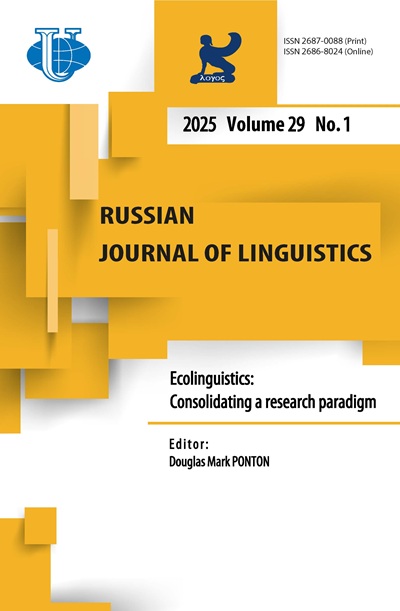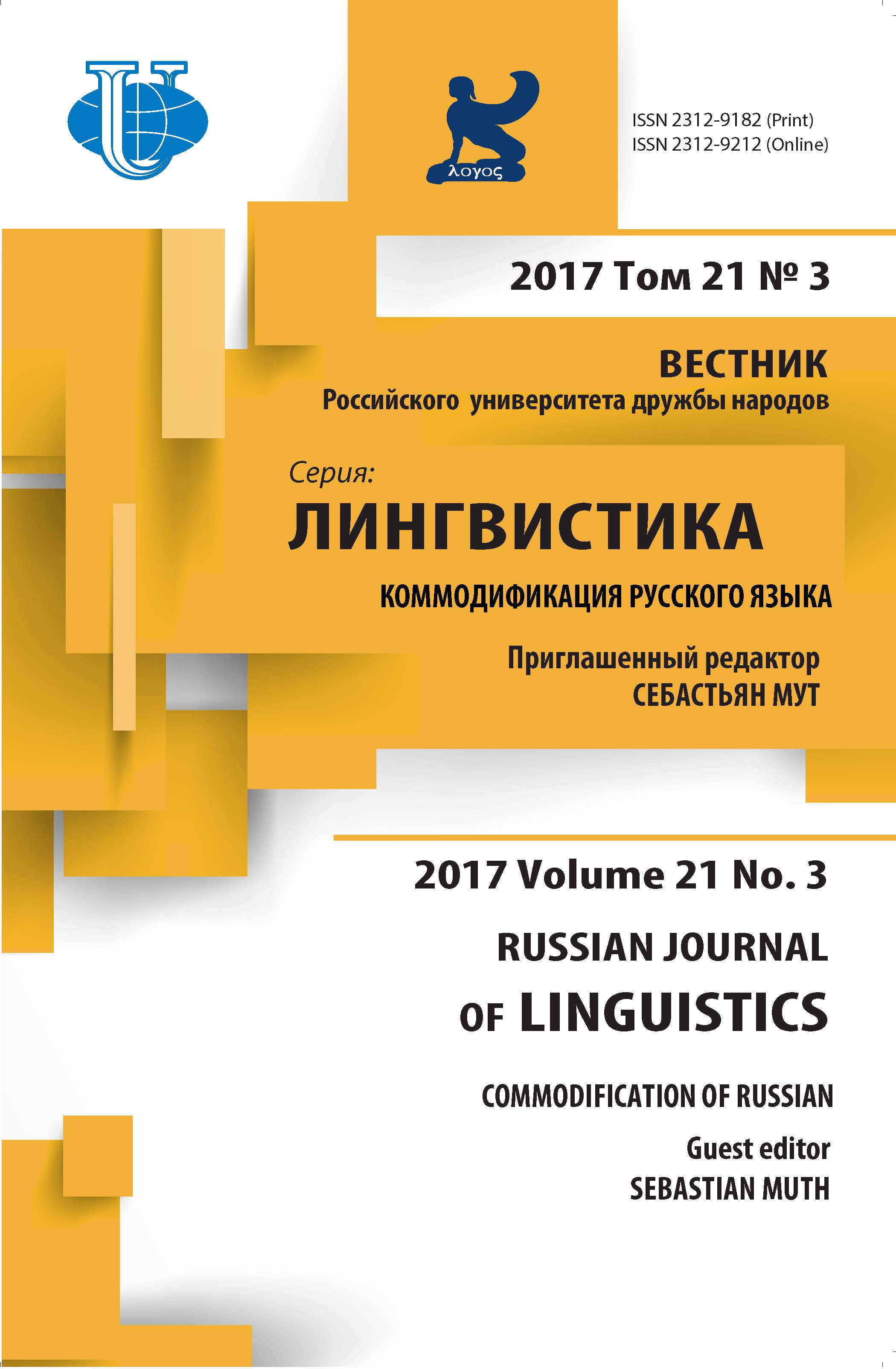Vol 21, No 3 (2017): Commodification of russian
- Year: 2017
- Articles: 14
- URL: https://journals.rudn.ru/linguistics/issue/view/995
- DOI: https://doi.org/10.22363/2312-9182-2017-21-3
Full Issue
Articles
RUSSIAN LANGUAGE ABROAD: VIEWING LANGUAGE THROUGH THE LENS OF COMMODIFICATION
Russian Journal of Linguistics. 2017;21(3):463-492
 463-492
463-492


LINGUISTIC LANDSCAPE AND OTHER SOCIOLINGUISTIC METHODS IN THE STUDY OF RUSSIAN LANGUAGE ABROAD
Abstract
Fieldwork research, including the articles in the present special issue, shows that in the past decade Russian has become one of the most popular and widely used languages in the global service in-dustry, tourism, and marketing, alongside English and Chinese. This historic moment opens up new oppor-tunities for researchers studying the uses of Russian language abroad. The purpose of the article is to survey sociolinguistic methods used in the study of Russian language abroad.
Russian Journal of Linguistics. 2017;21(3):493-514
 493-514
493-514


THE ROLE OF THE RUSSIAN LANGUAGE IN INDIA’S HEALTHCARE SECTOR
Abstract
The last few years have seen the influx of a new kind of tourist to India - medical tourists, coming in search of good quality and affordable treatments for a variety of medical procedures. With a large number of patients coming from Russia and countries of the former Soviet Union, the demand for local people with knowledge of Russian is steadily rising. Through ethnographic field work, which includes par-ticipant observations and interviews, this paper traces the development of the use of Russian in large private hospitals in Delhi, which have started attracting patients from the former Soviet Republics for medical services. The aim of the present paper is to introduce a pilot study of a relatively new sphere of economic activity where commodification of Russian language is acquiring a prominent place in India. My goal is to examine how Russian provides an added value to these hospitals in terms of the clientele they attract and how well it works for the clients themselves. In addressing these issues the paper aims to reveal the specific conditions and processes that characterize the use of Russian in ‘medical tourism’ in India and the motivation of the personnel involved. The results of the study indicate that commodification of the Russian language in India is an expanding phenomenon.
Russian Journal of Linguistics. 2017;21(3):515-529
 515-529
515-529


THE LANGUAGE OF “ETHNIC” MARKETS: BAZAAR AS A PIDGIN AND SITUATION OF BORDER
Abstract
The article analyzes the phenomenon of ethnic markets through the lens of the specific contact language (“bazaar Pidgin”), arising and used in the process of communication between traders and customers. The paper is based on a comparison of a peculiarity of “Chinese” markets in Russia and “Russian” market Yabaolu in China. The authors demonstrate that these markets reproduce similar communicative sphere. The article demonstrates that a language, performing the communicative function, marks non ethic basis of “ethnic” market, defining it as a border contact space. Based on a comparative analysis authors note that “bazaar pidgin” bear resemblance to contact Russian-Chinese frontier. The authors comes to the conclu-sion that the language, fixed in space markets of Irkutsk and Beijing, creates a situation, reproducing a num-ber of practices, which are typical for the cross-border contacts. These practices realize at a considerable distance from the state borders outside the legal and social context of the borderland. Based on this conclu-sion, the authors, that the change of the contact language of market is a good marker for fixation and analysis of changes in transboundary systems and streams, intersecting at the “ethnic” markets.
Russian Journal of Linguistics. 2017;21(3):530-556
 530-556
530-556


LINGUISTIC LANDSCAPE AND WHAT IT TELLS US ABOUT THE INTEGRATION OF THE RUSSIAN LANGUAGE INTO ISRAELI ECONOMY
Abstract
This essay analyzes the use of Russian in the linguistic landscape of Israel. Despite continu-ing hegemony of Hebrew, Russian has penetrated all spheres of public life, although concessions to multi-lingualism in Israeli society are hesitant and unsystematic. Russian written texts marking urban areas are unevenly distributed and reveal ethnic and social stratification of Israeli cities. The concentration of Russian signs is highest in business and commercial areas, where they target both domestic and international cus-tomers. The article focuses on the use of Russian in language-intensive domains and traces its influence on the symbolic economy in which cultural symbols are used as a marketing strategy.
Russian Journal of Linguistics. 2017;21(3):557-586
 557-586
557-586


RUSSIAN LANGUAGE IN NORTHERN NORWAY: HISTORICAL, ECONOMIC AND CULTURAL TIES
Abstract
This article addresses the topic “Commodification of the Russian language”. The author examines the process of commodification in the Norwegian city of Kirkenes and connects this phenomenon with the rise of the new economy and the current cooperation between Russia and Norway. The paper pre-sents an analysis of the linguistic landscape of Kirkenes, newspaper publications devoted to the “Russian Kirkenes” and interviews with Russian tourists and residents of the city. According to the author, the situation in Kirkenes illustrates the transition of the old economy into a new one: the former mining city turned into a tourist Mecca of the North, a center of cooperation of the Nordic countries. In such conditions, know-ledge of the Russian language becomes beneficial for the city's residents.
Russian Journal of Linguistics. 2017;21(3):587-604
 587-604
587-604


IS RUSSIAN DECOMMODIFYING IN CATALONIA?
Abstract
The data collected in an ethnographic study conducted between 2014 and 2016 in tourist areas in Catalonia, Spain shows that the mastery of Russian has become a profitable commodity in Spanish tourism industry. The purpose of this paper is to show where and how Russian is used in the service industry and trace the commodification of the language over time. Against the background of fluctuating numbers of Russian-speaking visitors, this analysis will contribute to a better understanding of processes of language commodification and decommodification and the relationship between wider political and economic con-texts and valorisation of particular languages and speakers.
Russian Journal of Linguistics. 2017;21(3):605-619
 605-619
605-619


ASPECTS OF COMMODIFICATION OF RUSSIAN IN FINLAND
Abstract
This article examines the commodification of Russian in Finland, where recent decades have seen a sharp rise in the size of the Russian-speaking population and the number of tourists from Russia. We particularly consider the use of Russian in the fields of traditional and medical tourism, education, and culture - all of them areas where Russian tourists show a strong preference for services in their native language. The need to provide a variety of services in Russian means that proficiency in Russian is a sig-nificant asset on the job market, both for immigrants and for the relatively small number of Finns who can speak the language. We also note that there is considerable demand among Russian-speaking parents in Fin-land for educational services to supplement their children’s school education.
Russian Journal of Linguistics. 2017;21(3):620-634
 620-634
620-634


RETOUR - AN INNOVATIVE RUSSIAN LANGUAGE TRAINING RESOURSE FOR TOURISM WORKERS IN THE EU
Abstract
This article investigates the role of the Russian language in the tourism sector. In particular it discusses learning materials for the self-study of Russian for tourism workers initiated by the European Union. The author shows the advantages of the online course Retur, which combines traditional methods with modern interactive multimedia teaching aids: video, audio and written teaching materials. In the article methods of selection of lexical and grammatical material, choice of thematic blocks and thematic units are discussed. The author comes to the conclusion that the tourism sector in a number of European countries is interested in training tourism workers in Russian in tourist services. Here, Russian as a foreign language becomes a demanded “commodity” that provides added value, and the teaching of Russian should serve as the formation of a communicative competence in Russian for future and current employees in tourism.
Russian Journal of Linguistics. 2017;21(3):635-652
 635-652
635-652


REVIEW of Zoya G. Proshina, Anna A. Eddy (2016) RUSSIAN ENGLISH (HISTORY, FUNCTIONS, AND FEATURES). Cambridge University Press, The University Publishing House, 329 pp. Cambridge CB2 8RU, UK
Russian Journal of Linguistics. 2017;21(3):653-655
 653-655
653-655


“GREAT RUSSIAN WORD”: The Third International Livadia Forum, Yalta, 5-6 June 2017
Russian Journal of Linguistics. 2017;21(3):656-658
 656-658
656-658


The Sixth International Conference «CURRENT ISSUES OF CONTEMPORARY LANGUAGE EDUCATION AT HIGHER SCHOOL: QUESTIONS OF LANGUAGE THEORY AND TEACHING METHODS» Kolomna, May 18-20, 2017
Russian Journal of Linguistics. 2017;21(3):659-666
 659-666
659-666


LANGUAGE IN CULTURE AND SOCIETY: MODERN PARADIGM AND NEW RESEARCHES Moscow, 26-27 May, 2017
Russian Journal of Linguistics. 2017;21(3):667-671
 667-671
667-671


INTERNATIONAL CONFERENCE RUSSIAN GRAMMAR: DESCRIPTION, TEACHING, TESTING, Helsinki, Finland, 7-9 June 2017
Russian Journal of Linguistics. 2017;21(3):672-675
 672-675
672-675

















